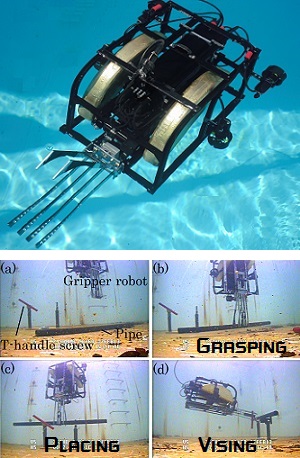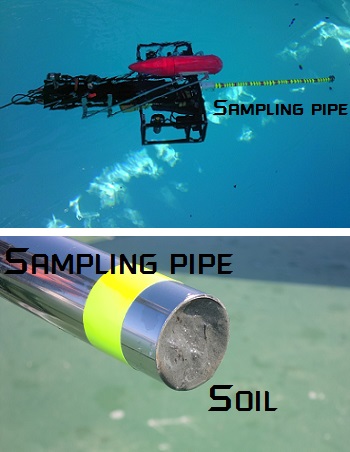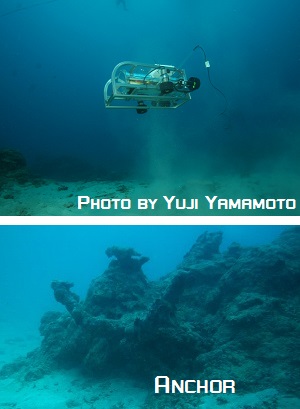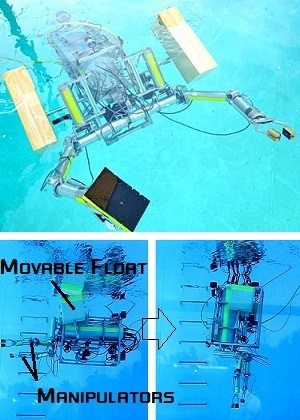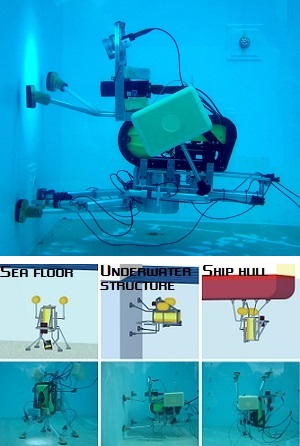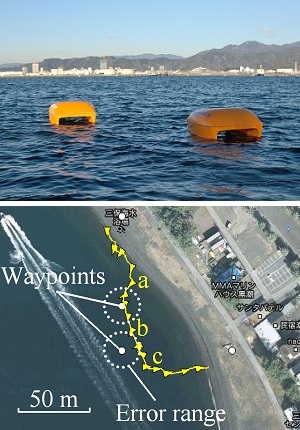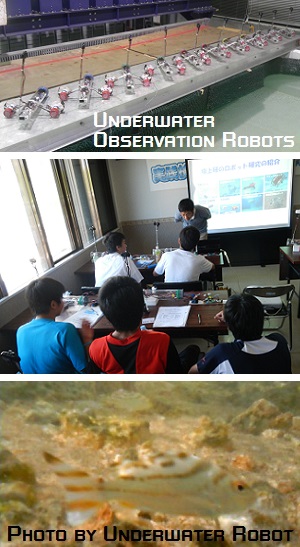
ARTEMI: Underwater 6 DOF Gripper Robot
|
We have developed an underwater 6 Degrees-Of-Freedom (DOF) gripper robot that is a human-portable Remotely Operated Vehicle (ROV).
The most important feature of this robot is that it can grasp a small and large cylindrical object of 50–500 mm diameter and handle it in 6 DOF even though it is human-portable.
We conducted an assembly task to demonstrate the effectiveness of the developed robot in a test tank. We are working jointly with Motion Intelligence Laboratory (Kawamura Lab. at Ritsumeikan Univ.) and OYO Corporation. |
|
MITSURUGI: Underwater Robot for Soil Core Sampling
|
We have designed and developed a human-portable underwater robot for use in soil core sampling.
The developed robot penetrates soil to collect a soil sample by outputting the thrust force.
The robot has an attitude control system based on a parallel link mechanism to reduce the drag force during navigation and sampling motion.
We have been testing autonomous sampling in Lake Biwa, Japan. We are working jointly with Motion Intelligence Laboratory (Kawamura Lab. at Ritsumeikan Univ.) and OYO Corporation. |
|
K-chan: Testbed Underwater Robot
|
The above underwater robots, ARTEMI and MITSURUGI, were developed based on the testbed underwater robot, K-chan.
We pretested electrical circuit boards and software using this underwater robot. K-chan is now used for underwater archaeological survey and for archaeological education in Ishigaki Island, Japan. We also use K-chan to demonstrate the effectiveness of an underwater position measurement system with a single camera that is a collaborative research with Takemura Laboratory at Okinawa National College of Technology |
|
CoCo: Human-sized Underwater Robot with Two Manipulators
|
We have developed a human-sized underwater robot that has two 5 DOF manipulators and an attitude control system.
The attitude control system is based on control of the position of the center of buoyancy and is useful not only for attitude maintenance but also for attitude change control. This robot was designed for an alternative to divers. That's why the developed robot is human-sized (small and lightweight), has two human-sized manipulators, and can change its attitude. The operation can be inexpensively conducted from small boats. We worked jointly with Motion Intelligence Laboratory (Kawamura Lab. at Ritsumeikan Univ.) and SCREEN Holdings Co., Ltd.. |
|
Discovery: Underwater Robotic Inspection System
|
We designed and developed an underwater robotic inspection system with a mechanical contact mechanism
that enhances the positioning stability of a small and lightweight underwater robot
to take clear images and to work with manipulators under external disturbances.
Thrusters are used to push the underwater robot to an underwater object and to generate friction force
between the contact points and the object.
A ship hull inspection was conducted using this robot at Shimizu port in Shizuoka, Japan. We worked jointly with Motion Intelligence Laboratory (Kawamura Lab. at Ritsumeikan Univ.) and SCREEN Holdings Co., Ltd.. |
|
Autonomous Wave-Powered Boat with Wave Devouring Propulsion System
|
We have developed an autonomous waved-powered boat with Wave Devouring Propulsion System (WDPS).
The WDPS consists of two fins below the bow of the boat and generates thrust force directly from wave power.
We have conducted tank tests and field experiments in Orido bay to demonstrate the effectiveness of the developed autonomous wave-powered boat. We worked jointly with Prof. Terao of Navigation and Ocean Engineering at Tokai University. |
|
Robots for Ocean Environmental Education
|
We hold environmental education events in Ishigaki Island, Japan.
One of the programs offers the high school students and junior high school students an opportunity to learn about ocean environment.
They build underwater observation robots by themselves and learn about underwater environment using the robots.
We have developed robots controlled by smartphones and tablet computers for the event this year. In another program, we take the high students in Ishigaki Island to nearby an underwater cultural heritage site and they learn about the heritage using our underwater robot, K-chan. |
|
